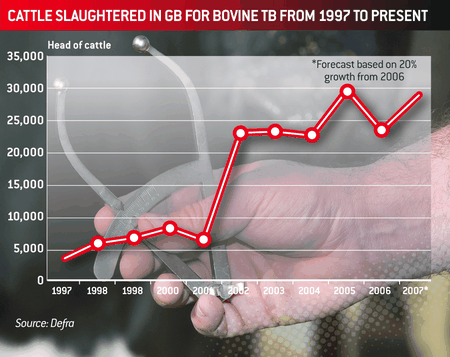TB test results raise questions
The use of the gamma-interferon test has been of negligible benefit in DEFRA’s attempts to improve detection rates of cattle infected with bovine tuberculosis, according to information obtained by Farmers Weekly under the Freedom of Information Act.
FW made the request to Animal Health (formerly the State Veterinary Service) under the FoI Act for data on the test’s performance since its introduction as a policy mainstay last year.
During the period between its approval for field use in October 2006 and the 23 August this year 25,984 cattle were tested with gamma-interferon at a cost of £337,792.
Of those, 22,240 (86%) returned a negative result, 1881 (7%) returned a positive and 1863 (7%) returned a “no result” because the sample taken failed to be of sufficient quality for analysis.
The average cost of using the gamma-interferon test per positive animal was £179.58.

Disease spread
Meanwhile the disease continues to spread. TB statistics published last Thursday (6 September) reveal that during July a further 2314 cattle were slaughtered for TB control measures, an increase of 25% on the same month last year bringing the total for 2007 to 16,461.
The west of England, the worst affected region of Britain, experienced an 18% rise in new herd breakdowns compared with 2006. The number of cattle slaughtered in the region now stands at 9549, up 19% on 2006.
David Fursdon, president of the Country Land and Business Association, said: “These figures clearly make the case for an end to the platitudes we’ve had for a long time now. The industry needs action to control this disease.
“I would like to ask the Secretary of State why the scientists are taking so long to find a solution. Is it a question of insufficient resources?
“And why is it acceptable to continue to slaughter cattle, but not to touch badgers when it is acknowledged that they are a ‘significant contributor to the spread of the disease’?
“Livestock farmers are already facing a difficult year and they continue to be asked to take on extra costs for animal disease control when they are not proper partners with DEFRA in devising a solution to the problem.”
